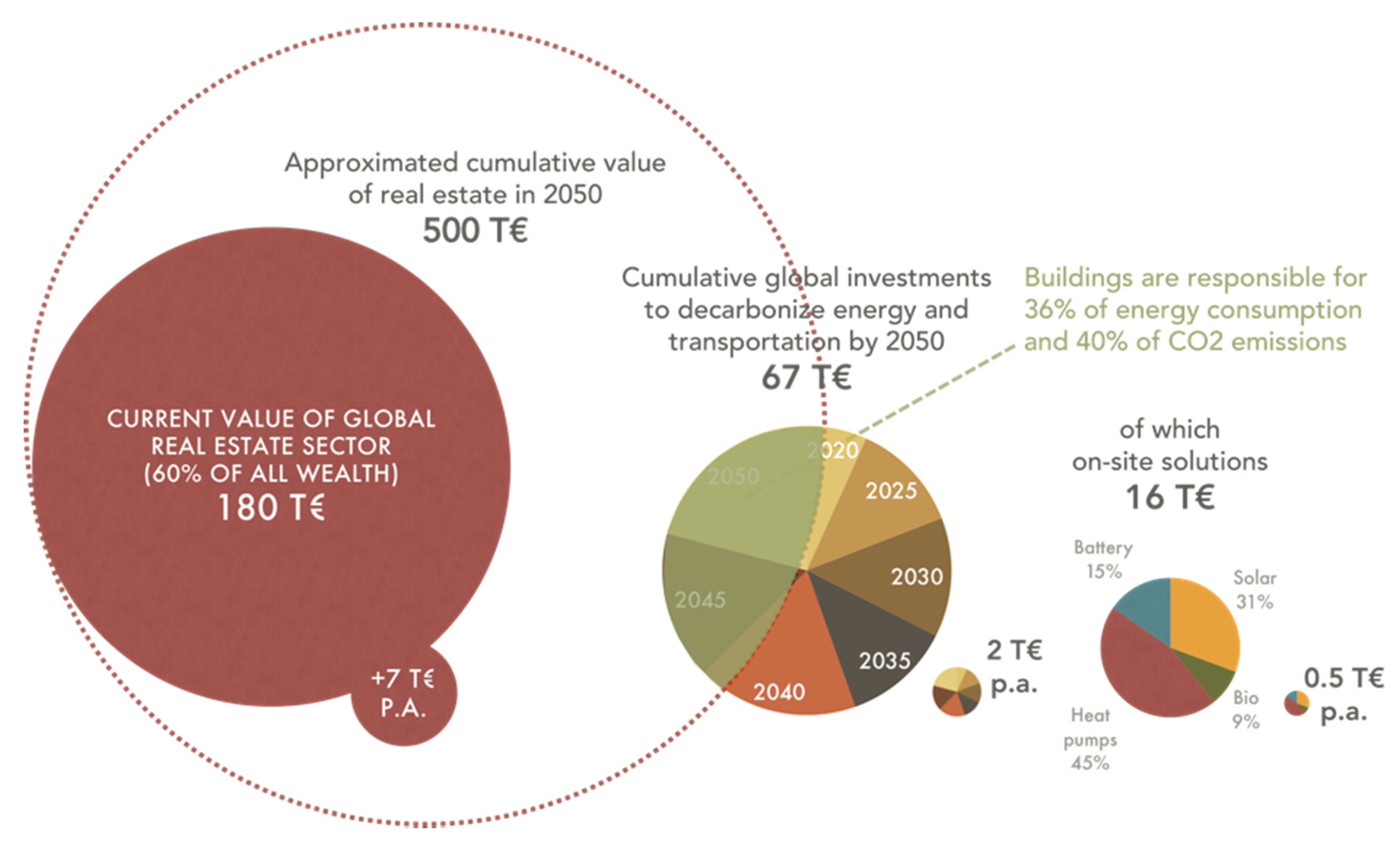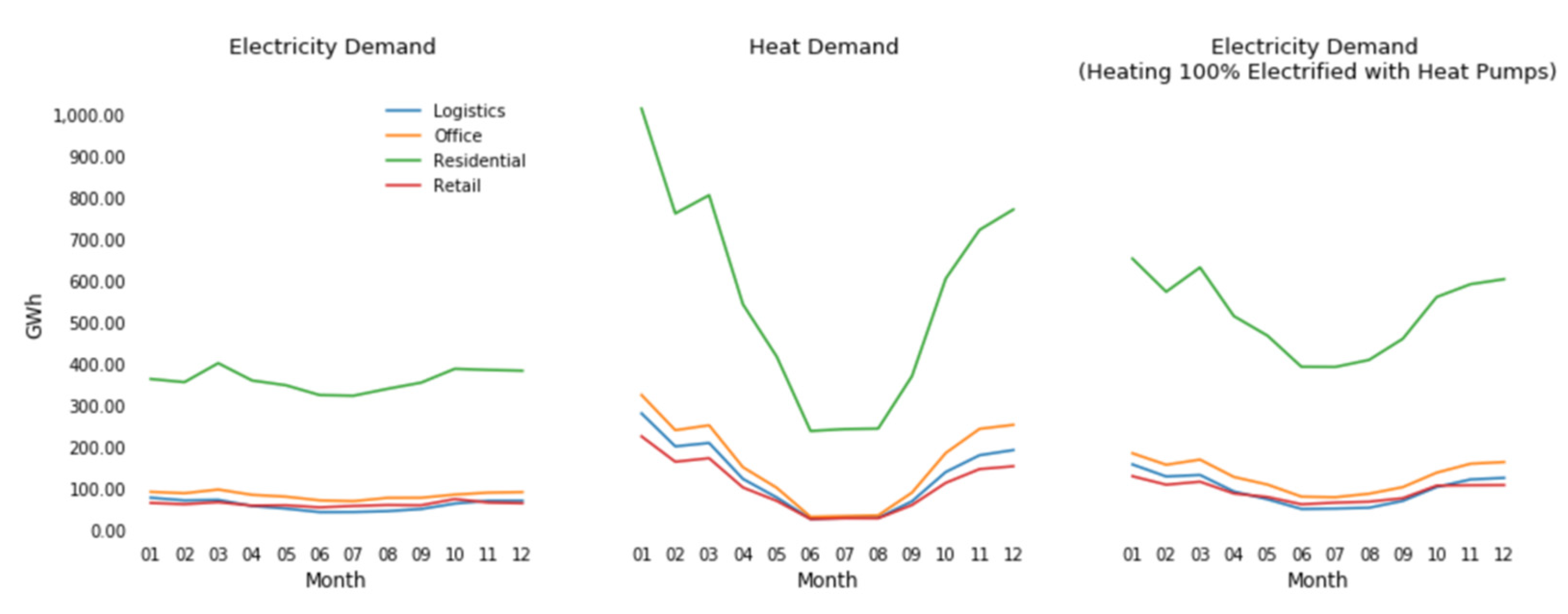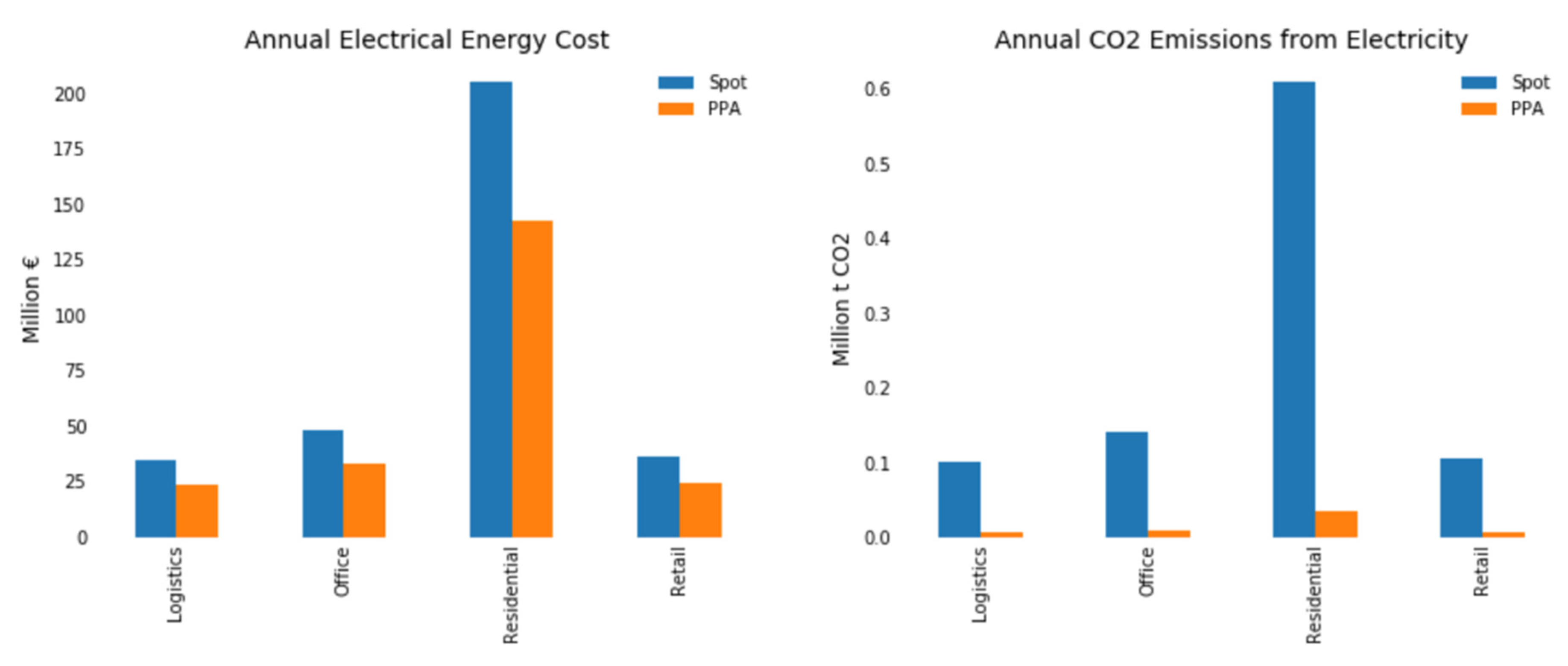Financing Energy Transition with Real Estate Wealth
Abstract
:1. Introduction
2. Materials and Methods
2.1. Bottom–up Energy and Economic Model for a City
2.2. Country Profiles for Real Estate Power Purchase Agreements
3. Results
3.1. Collateral Strength of Real Estate
3.2. Global Potential of Real-Estate-Backed Power Purchase Agreements
4. Discussion
Funding
Conflicts of Interest
References
- Ram, M.; Bogdanov, D.; Aghahosseini, A.; Oyewo, S.; Gulagi, A.; Child, M.; Breyer, C. Global Energy System Based on 100% Renewable Energy—Power Sector; Lappeenranta University of Technology and Energy Watch Group: Lappeenranta, Finland, 2017. [Google Scholar]
- Schmidt, T.S. Low-carbon investment risks and de-risking. Nat. Clim. Chang. 2014, 4, 237–239. [Google Scholar] [CrossRef]
- Creutzig, F.; Agoston, P.; Goldschmidt, J.C.; Luderer, G.; Nemet, G.; Pietzcker, R.C. The underestimated potential of solar energy to mitigate climate change. Nat. Energy 2017, 2, 17140. [Google Scholar] [CrossRef]
- Corporate Clean Energy Buying Leapt 44% in 2019, Sets New Record. Available online: https://about.bnef.com/blog/corporate-clean-energy-buying-leapt-44-in-2019-sets-new-record/ (accessed on 1 July 2020).
- Innovation in Power Purchase Agreement Structures. Available online: https://www.wbcsd.org/Programs/Climate-and-Energy/Energy/REscale/Resources/Innovation-in-Power-Purchase-Agreement-Structures (accessed on 1 July 2020).
- What Price the World? Real Estate in the Global Asset Universe. Available online: https://pdf.euro.savills.co.uk/global-research/around-the-world-in-dollars-and-cents-2016.pdf (accessed on 1 July 2020).
- McKinsey Global Institute, Reinventing construction: A Route to Higher Productivity. Available online: https://www.mckinsey.com/~/media/McKinsey/Industries/Capital%20Projects%20and%20Infrastructure/Our%20Insights/Reinventing%20construction%20through%20a%20productivity%20revolution/MGI-Reinventing-Construction-Executive-summary.ashx (accessed on 1 July 2020).
- From Thousands to Billions: Coordinated Action towards 100% Net Zero Carbon Buildings By 2050. Available online: https://www.worldgbc.org/sites/default/files/From%20Thousands%20To%20Billions%20WorldGBC%20report_FINAL%20issue%20310517.compressed.pdf (accessed on 1 July 2020).
- IEA. Energy Efficiency: Buildings. Available online: https://www.iea.org/topics/energyefficiency/buildings/ (accessed on 1 July 2020).
- Buildings in Helsinki. Available online: https://www.avoindata.fi/data/en_GB/dataset/helsingin-rakennukset (accessed on 1 July 2020).
- Buildings in Espoo. Available online: https://www.avoindata.fi/data/en_GB/dataset/espoon-rakennukset (accessed on 1 July 2020).
- Buildings in Vantaa. Available online: https://www.avoindata.fi/data/en_GB/dataset/vantaan-rakennukset (accessed on 1 July 2020).
- Vantaa Energy Ltd. Building Heat Consumption Data. 2019. Available online: https://www.vantaanenergia.fi/en/ (accessed on 1 July 2020).
- Energy Consumption Data of City of Helsinki’s Utility and Service Properties. Available online: https://hri.fi/data/en_GB/dataset/helsingin-kaupungin-palvelukiinteistojen-energiankulutustietoja (accessed on 1 July 2020).
- Historical Market Data (Elspot Prices Hourly 2019 EUR). Available online: https://www.nordpoolgroup.com/historical-market-data/ (accessed on 1 July 2020).
- Valtava Tuulivoimalabuumi Alkaa nyt Etelä-Pohjanmaalla—Valmisteilla 80 Tuulivoimalan Rakentaminen. Available online: https://www.talouselama.fi/uutiset/valtava-tuulivoimalabuumi-alkaa-nyt-etela-pohjanmaalla-valmisteilla-80-tuulivoimalan-rakentaminen/23205535-8686-4e1b-b162-afa12f09c48c (accessed on 1 July 2020).
- Datscha. Property Information Data. 2018. Available online: https://datscha.com (accessed on 1 July 2020).
- Baum, A.E.; MacGregor, B.D. The initial yield revealed: Explicit valuations and the future of property investment. J. Prop. Valuat. Invest. 1992, 10, 709–726. [Google Scholar] [CrossRef]
- Leskinen, N.; Vimpari, J.; Junnila, S. Using real estate market fundamentals to determine the correct discount rate for decentralised energy investments. Sustain. Cities Soc. 2020, 53, 101953. [Google Scholar] [CrossRef]
- Shapiro, E.; Mackmin, D.; Sams, G. Modern Methods of Valuation; EG Books: Bairnsdale, Australia, 2013. [Google Scholar]
- Wiley, J.A.; Benefield, J.D.; Johnson, K.H. Green design and the market for commercial office space. J. Real Estate Financ. Econ. 2010, 41, 228–243. [Google Scholar] [CrossRef]
- Leskinen, N.; Vimpari, J.; Junnila, S. The impact of renewable on-site energy production on property values. J. Eur. Real Estate Res. 2020. [CrossRef]
- Cerin, P.; Hassel, L.G.; Semenova, N. Energy performance and housing prices. Sustain. Dev. 2014, 22, 404–419. [Google Scholar] [CrossRef]
- Fuerst, F.; McAllister, P.; Nanda, A.; Wyatt, P. Does energy efficiency matter to home-buyers? An investigation of EPC ratings and transaction prices in England. Energy Econ. 2015, 48, 145–156. [Google Scholar] [CrossRef] [Green Version]
- Marmolejo-Duarte, C.; Chen, A. The Uneven Price Impact of Energy Efficiency Ratings on Housing Segments. Implications for Public Policy and Private Markets. Sustainability 2019, 11, 372. [Google Scholar] [CrossRef] [Green Version]
- Leskinen, N.; Vimpari, J.; Junnila, S. A review of the impact of green building certification on the cash flows and values of commercial properties. Sustainability 2020, 12, 2729. [Google Scholar] [CrossRef] [Green Version]
- Fuerst, F.; McAllister, P. Green noise or green value? Measuring the effects of environmental certification on office values. Real Estate Econ. 2011, 39, 45–69. [Google Scholar] [CrossRef]
- Eichholtz, P.; Kok, N.; Quigley, J.M. Doing well by doing good? Green office buildings. Am. Econ. Rev. 2010, 100, 2492–2509. [Google Scholar] [CrossRef] [Green Version]
- S & P Global Ratings. Available online: https://www.spglobal.com/ratings/en/about/understanding-ratings (accessed on 1 July 2020).
- Price Rankings by Country. Available online: https://www.numbeo.com (accessed on 1 July 2020).
- Energy Use (kg of Oil Equivalent Per Capita). Available online: https://data.worldbank.org/indicator/EG.USE.PCAP.KG.OE (accessed on 1 July 2020).
- Federal Reserve Economic Data. Available online: https://fred.stlouisfed.org (accessed on 1 July 2020).
- Helen Ltd. Business Year 2019. Available online: https://www.helen.fi/en/annual-report/annual-report-2019/year-2019/business-year (accessed on 1 July 2020).
- Motiva, CO2 Emission Coefficient for Finnish Electricity System. Available online: https://www.motiva.fi/ratkaisut/energiankaytto_suomessa/co2-laskentaohje_energiankulutuksen_hiilidioksidipaastojen_laskentaan/co2-paastokertoimet (accessed on 1 July 2020).
- Wang, Y.; Sun, T. Life cycle assessment of CO2 emissions from wind power plants: Methodology and case studies. Renew. Energy 2012, 43, 30–36. [Google Scholar] [CrossRef]
- Darling, S.B.; You, F.; Veselka, T.; Velosa, A. Assumptions and the levelized cost of energy for photovoltaics. Energy Environ. Sci. 2011, 4, 3133–3139. [Google Scholar] [CrossRef]
- Ondraczek, J.; Komendantova, N.; Patt, A. WACC the dog: The effect of financing costs on the levelized cost of solar PV power. Renew. Energy 2015, 75, 888–898. [Google Scholar] [CrossRef]
- Proxy Generation PPAs: The Next Evolution of PPAs for the Corporate & Industrial Buyer. Available online: https://orrick.blob.core.windows.net/orrick-cdn/Proxy_Generation_PPAs.pdf (accessed on 1 July 2020).




| COUNT | MEAN | STD | MIN | MEDIAN | MAX | SUM | ||
|---|---|---|---|---|---|---|---|---|
| Property Value (1000 €) | Logistics | 3903 | 1724 | 6014 | 28 | 418 | 236,066 | 6,728,914 |
| Office | 2675 | 10,469 | 18,641 | 66 | 3480 | 181,387 | 28,005,311 | |
| Residential | 79,984 | 2257 | 5563 | 124 | 632 | 218,885 | 180,532,418 | |
| Retail | 1721 | 12,498 | 42,698 | 43 | 1112 | 709,374 | 21,509,385 | |
| Total | 88,283 | 2682 | 8922 | 28 | 644 | 709,374 | 236,776,028 | |
| Rent p.a. (1000 €) | Logistics | 3903 | 262 | 695 | 7 | 71 | 19,277 | 1,021,111 |
| Office | 2675 | 978 | 1384 | 15 | 504 | 18,672 | 2,615,136 | |
| Residential | 79,984 | 143 | 287 | 14 | 44 | 8609 | 11,457,415 | |
| Retail | 1721 | 854 | 2178 | 10 | 159 | 34,128 | 1,470,373 | |
| Total | 88,283 | 188 | 525 | 7 | 46 | 34,128 | 16,564,035 | |
| Electricity Spot Costs p.a. (1000 €) | Logistics | 3903 | 8.8 | 23.6 | 0.1 | 2.2 | 611.9 | 34,215 |
| Office | 2675 | 18.0 | 25.0 | 0.3 | 9.6 | 343.4 | 48,139 | |
| Residential | 79,984 | 2.6 | 4.8 | 0.4 | 0.8 | 116.9 | 205,103 | |
| Retail | 1721 | 21.1 | 44.6 | 0.1 | 5.8 | 555.2 | 36,392 | |
| Total | 88,283 | 3.7 | 10.8 | 0.1 | 0.9 | 555.2 | 323,849 | |
| Electricity Spot Costs per Rent (%) | Logistics | 3903 | 3.1% | 1.8% | 0.6% | 2.4% | 7.9% | 3.4% |
| Office | 2675 | 2.0% | 0.6% | 0.8% | 2.0% | 4.2% | 1.8% | |
| Residential | 79,984 | 1.9% | 0.3% | 1.1% | 1.9% | 3.9% | 1.8% | |
| Retail | 1721 | 4.1% | 2.0% | 0.1% | 4.1% | 13.2% | 2.5% | |
| Total | 88,283 | 2.0% | 0.7% | 0.1% | 1.9% | 13.2% | 2.0% |
© 2020 by the author. Licensee MDPI, Basel, Switzerland. This article is an open access article distributed under the terms and conditions of the Creative Commons Attribution (CC BY) license (http://creativecommons.org/licenses/by/4.0/).
Share and Cite
Vimpari, J. Financing Energy Transition with Real Estate Wealth. Energies 2020, 13, 4289. https://doi.org/10.3390/en13174289
Vimpari J. Financing Energy Transition with Real Estate Wealth. Energies. 2020; 13(17):4289. https://doi.org/10.3390/en13174289
Chicago/Turabian StyleVimpari, Jussi. 2020. "Financing Energy Transition with Real Estate Wealth" Energies 13, no. 17: 4289. https://doi.org/10.3390/en13174289





